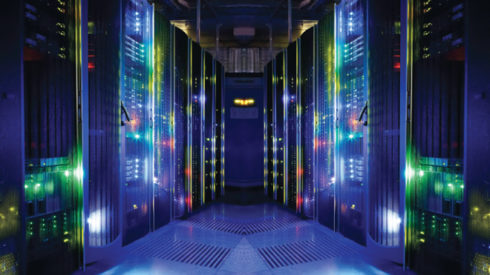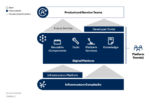
“After the last nuclear bomb goes off and the earth cools, and the cockroaches come back out of the ground, they will all be dragging mainframes with them because it’s the only platform that will be able to withstand that,” Thomas Klinect, a senior research director at Gartner, told SD Times.
While Klinect was joking when he made that comment during an interview with SD Times, the point he was trying to stress was that mainframes aren’t going anywhere anytime soon and should stop being looked at as legacy technology.
Mainframes have a misconception that they are these behemoth systems that are slow and require a lot of support, but with hardware and software advancement made over the last several decades, mainframes are now modern, efficient and fast platforms, Klinect explained.
RELATED CONENT:
COVID-19 pandemic response puts mainframes back in spotlight
7 mainframe fallacies and the truths you need to know
The hurdle that still stands in the way of bringing mainframes into modern, digital transformations is the application development and delivery aspect. Traditionally, updates to applications on the mainframe are difficult and release cycles are too long — so organizations have left mainframes out of modern development and delivery initiatives like Agile and DevOps, causing gaps in the development life cycle, Klinect explained.
In addition, a report from Forrester found that because mainframe developers struggle with compliance processes, lack of application modularity, manual processes and inconsistent dev times when it comes to dealing with mainframe apps, it is putting a hindrance on their ability to innovate.
But as organizations try to move faster and be competitive, it is becoming apparent that existing mainframe investments can no longer be ignored as part of the digital journey.
“Something that most businesses have learned over the last 20 years is they have to evolve the way they are doing application development,” said Sam Knutson, vice president of product management at Compuware. “In order to do mainframe development and meet the needs of customers, we have to work in a different way.”
Forrester also found a majority of organizations are looking to modernize the mainframe, with 82% finding DevOps as a critical or high priority task.
Additionally, Compuware is currently conducting a survey on the state of mainframes, and preliminary results found 78% of respondents would find it useful if they could update mainframe applications more frequently than they currently do, 56% are using DevOps on the mainframe, and respondents who have adopted DevOps see a return on investment in one year or less.
“Mainframes lack the flexibility that businesses require to succeed in the digital world. Organizations face both business and technical challenges on the mainframe, preventing them from innovating and transforming into a digital business. To avoid issues with the mainframe, organizations are working around it, replatforming, or modernizing. However, each of these tactics creates new issues. The good news is that those companies embracing DevOps deliver faster and at a higher quality, all while fostering collaboration,” Forrester wrote in its report.
Why should you bring mainframe into DevOps initiatives
According to Knutson, DevOps is one of the biggest driving forces that has come into the application development space because it changes how enterprises think and deliver software. Customers want work delivered in small batches, shorter release cycles and capabilities as soon as they are ready — exactly what DevOps promises.
By not including mainframes in the DevOps conversation, the mainframe space has become siloed and left out of modern tooling, technologies and investments being made — which results in the inability to move faster or remain competitive, according to Eddie Houghton, director of product management for mainframe and enterprise solutions at Micro Focus.
“You have to be able to respond quickly to a rapidly changing marketplace and particularly from a consumer perspective, there is no real customer loyalty now. So to be able to actually differentiate yourself you have to be able to offer services faster and that is the thing that is underpinning and driving that digital transformation in terms of those services you can actually offer out to your customers so you can remain competitive,” said Houghton.
Mainframe modernization should not be confused with lift and shift or rip and replace, Knutson stressed. There are decades and decades of work that have gone into mainframes, and trying to recreate it by replatforming an application is a waste of time and will make a company stand still as competitors march forward.
Additionally, Houghton added that trying to lift and shift mainframes that essentially have 200 to 400 million lines of code is an absolutely colossal undertaking and introduces a huge amount of risk and pressure to do it in a desirable time frame. “These are services that are providing real value to you. The lower risk approach is to say what are the things that are stopping me from moving quickly. By bringing mainframe development into a more Agile framework allows you to actually accelerate the delivery of change from cutting the code through to actually deploying it to production,” he said.
The way to go about doing that is to understand how you currently develop today, what tools you are using, where your challenges are and what the culture of the business is.
According to Houghton, organizations can implement tools to understand what is on the mainframe and how the data, code and solutions are connected. Once that is established, then they can start making decisions about what to do with those applications.
A lot of advancements have also been made in the mainframe DevOps tool space over the last couple of years to make it easier to achieve mainframe agility. For instance IBM, developer of the most commonly used mainframe servers, has worked over the last couple of years to provide a common developer experience for development, test, automation and integration. Mainframes have also been updated with a modern UI experience and now support web interfaces as well and open source tools.
There has also been an increase in hybrid applications such as mobile front ends and cloud-based integrations, making solutions more accessible on the mainframe, according to Peter Wassel, director of product management for the Broadcom Mainframe Software Division. Wassel added that the industry has now reached the tipping point where closed, proprietary tools and waterfall processes are no longer acceptable.
“Businesses running mainframes need to break through the silos, and unlock their assets for competitive advantage, especially against digital natives whose developers already use DevOps,” said Wassel.
The key to success is to make sure DevOps for the mainframe is no different from any other platform developers are using. With modern tools available, the same tools, technologies and languages can be used across the mainframe, cloud and other initiatives, Wassel explained.
“Mainframe people, processes, and technology are being incorporated into already established enterprise DevOps initiatives, rather than designing a separate mainframe DevOps,” Wassel said. “By creating this bridge, you eliminate the notion of the mainframe as being ‘separate’ from the cloud, and enable businesses to modernize in place.”
How to attract talent
One of the biggest challenges, but also benefits to bringing mainframes to DevOps, is that it brings to light the mainframe talent shortage. Current mainframe developers are older and have worked in waterfall environments their entire life, according to Gartner’s Klinect. Learning new tools and capabilities doesn’t come as easy to them and they are not accustomed to change, so it’s important to start looking for ways to bring new talent in.
The next generation of developers coming out of college are used to working with Agile development, continuous integration, and modern IDEs, Micro Focus’ Houghton explained. They aren’t going to want to come into an environment that is antiquated and difficult to learn.
“Companies have been very accustomed to hiring distributed staff and have forgotten how to hire for the mainframe. They are starting to realize the staff that is there is retirement eligible and therefore they have to replace them,” said Klinect. “When you begin to understand why candidates don’t apply for mainframe jobs it is because the platform is typically produced in the ecosystem as being a legacy platform. Something that is going away and will disappear and if you get on there you are going to lose your life and never make it in IT.”
The reality is that mainframe is a very crucial and valuable component of the organization, it just needs to keep pace with the changes happening, according to Lisa Dyer, vice president of product management at Ensono.
“You need skills not just for today, but for tomorrow. We have this whole giant pool of developers who if we give them modern IDEs it just makes mainframe code another language for my developer and lets them use whatever tools they want,” Dyer explained.
Broadcom’s Wassel suggested to focus on finding people who are the right “fit” for the company with the right intellectual aptitude and drive rather than going into the hiring process with a checklist of technical skills and experience.
“Employers should think of the talent they bring on board as an investment that will span multiple years, rather than as a quick fix to address what may be a short-term need. This investment calls for training,” Wassel explained.
There are tools such as zAdviser designed to help organizations understand where individual developers are struggling and provide training for that individual rather than just trying to apply broad training across the organization and make them magically Agile, Klinect explained.
The point to remember is that change doesn’t just happen at the developer level and it’s a culture change that needs to happen throughout the entire enterprise.
“I would say apathy is a big problem,” said Compuware’s Knutson. “There are still far too many customers who look at the mainframe as an asset that can only be reduced in costs. They try to drive out costs at all costs, look at outsourcing, buy the cheapest tools possible and then are shocked when they don’t get the results or outcomes they wanted. All the customer success stories I talk about are customers who look at this from the top down as a critical step for the firm and recognize that cultural and technology change is required in order to get more value from it and these systems can actually move the needle for the entire company.”
The next phase of mainframe modernization
As the cloud takes center stage in digital transformation efforts, organizations will have to learn how to incorporate cloud initiatives with mainframe initiatives.
“As enterprises move mission-critical workloads to the cloud, a key step along the way will be modernization. Modernization shouldn’t be confused with moving away from the mainframe – rather, the mainframe is a part of most of our clients’ hybrid cloud journeys by helping our clients modernize their applications – not the platform. As clients look toward modernizing applications for hybrid cloud, it will be key for them to leverage a set of common, standardized tools to enable DevOps across the enterprise,” said Rosalind Radcliffe, distinguished engineer and chief architect of DevOps for Enterprise Systems at IBM.
Ensono’s Dyer warns about getting too caught up with the promise of the cloud. She explained there will be a lot of conversations and bias to move stuff off the mainframe into the cloud, but that’s because cloud vendors want you to use their platforms. Dyer isn’t saying that mainframe applications shouldn’t be moved to the cloud, but she says not all mainframes apps need to get off the mainframe. Companies have to utilize a hybrid IT platform today and figure out what are the right platforms for the right workloads, and how to establish a frictionless connectivity and way of working.
Systems of engagement such as mobile and web apps may not be well-suited to the mainframe and may need a more hyperscale platform, but will still need connectivity into the systems of records — which still exist on the mainframe, Dyer explained.
“Many services these days rely on a mobile front-end, but still benefit enormously from the strength of the mainframe to deliver the optimum end user experience marked by scale, resilience, security, availability, and data protection,” Broadcom’s Wassel added.
Micro Focus’ Houghton sees a trend of more cloud vendors starting to tackle the mainframe if they want to address getting infrastructure customers have today.
However, Gartner’s Klinect says adapting mainframes for the cloud is like putting a round peg in a square hole. While mainframes are very similar to the cloud in terms of paying for CPU usage and supporting RESTful interfaces and open-source tools, the connection just isn’t there yet. He explained the licensing model for software on the mainframe isn’t built for the cloud yet, but they are evolving and changing as more open source becomes available on the platform so he expects the problem will be worked out in a couple of years.
“Once those two models merge, and mainframe becomes more flexible and the realization cloud charges for the same process cycles that a mainframe would, I believe we will see a blurring of the lines between what’s a mainframe and what’s a distributed box,” he said






